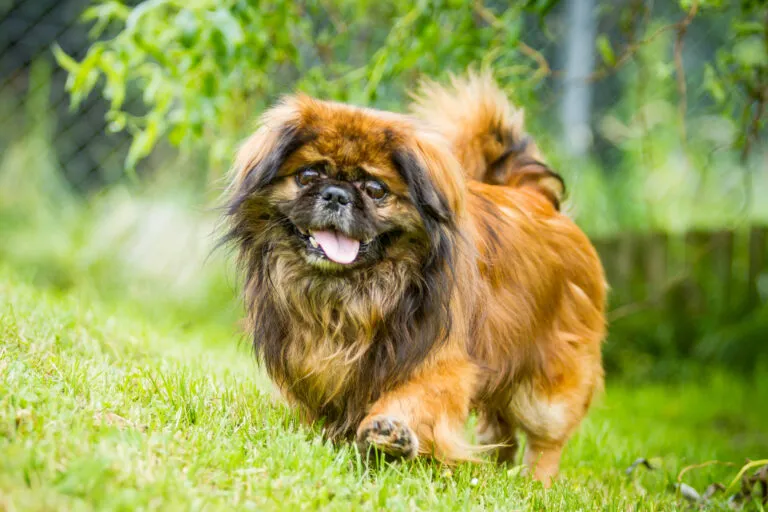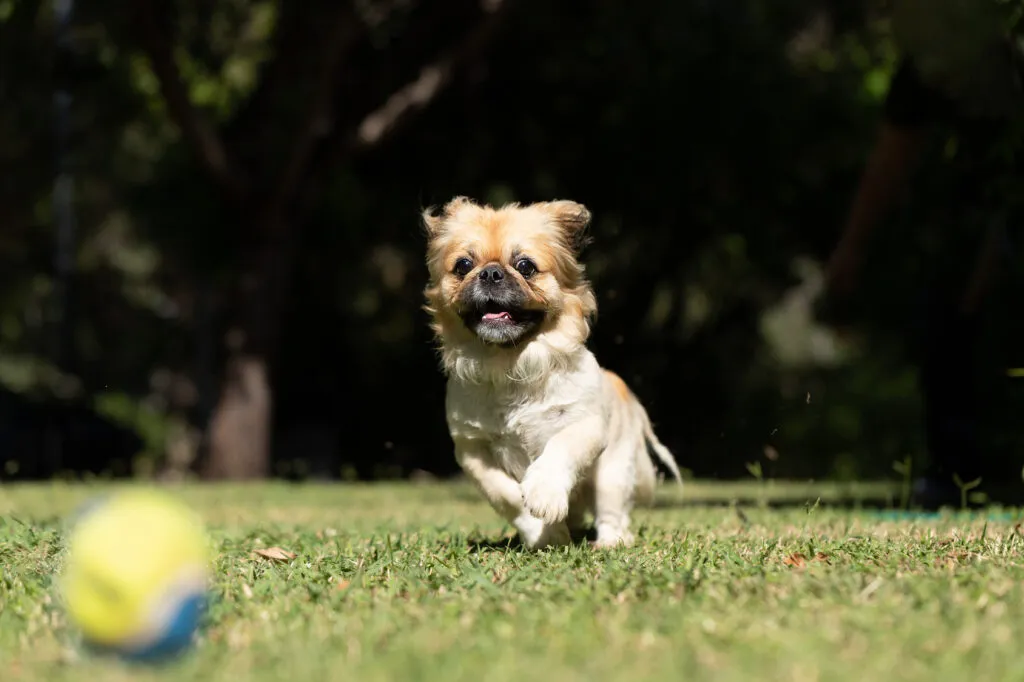Medium Size Poodle
Once a highly esteemed and exclusive palace guardian in China, the Pekingese – also known as "Pekinese" or "Peking Palace Dog" – is now much more widespread. However, this popularity has left some negative marks on this traditional breed. Extreme breeding has affected its health. Nevertheless, there are more and more efforts to achieve a balanced and therefore healthy appearance for this venerable dog.

© hemlep / stock.adobe.com
The noble Pekingese: a charming companion with a distinctive look.
Large eyes, flat nose, and plenty of fur: Over the centuries, the former temple guardian has changed significantly. Today, the Pekingese is a small dog weighing up to 5.4kg with a lush coat. The top coat is long, straight, and somewhat coarse to the touch. In contrast, the undercoat is soft and very dense.
According to the standard, a mask is desired: This refers to the dark pigmentation of the nose, lips, and eyelids. A striking feature of the Pekingese is its large head, relatively massive compared to its body, with a flat profile and large eyes. It carries its rod high set over its back and slightly bent to the side.
 © T.Den_Team / stock.adobe.com
© T.Den_Team / stock.adobe.com
Like the Lhasa Apso, the Pekingese can look back on a long tradition as a palace dog. Another similarity is the additional designation “Lion Dog”. Legend has it that the dog originated from a union between a lion and a female monkey, which – allegedly – can also be seen in its appearance.
Pekingese have always been considered special and guarded Chinese temples for centuries. The theft of these animal guardians was punishable by death. Numerous figurines testify that the ancestors of the modern Pekingese, especially during the Qing Dynasty (1644 – 1912), experienced a heyday.
In 1860, the Pekingese took the first steps into the western world: That year, Great Britain conquered Beijing, and five of the valuable dogs were taken to England as war booty. One of them not only became the progenitor of European Pekingese but also lived with dog lover Queen Victoria, who named it “Looty” – derived from the English word “loot” for “war booty”.
Despite its small size, this dog quickly attracted attention at exhibitions in Europe and was further bred. In 1898, the breed received official recognition from the British Kennel Club. Soon, the once very exclusive Lion Dogs began a conquest of the hearts of numerous dog lovers across Europe. The breed, originally from China, is now under the patronage of Great Britain.
The little Lion Dog was extraordinary upon its arrival in Europe. Unfortunately, enthusiasm for the dog from the Middle Kingdom led to a tendency toward extremes in breeding, which harmed the breed. Selective breeding resulted in increasingly larger eyes, flatter noses, and more abundant hair. Since then, many Pekingese have been born with respiratory and eye problems from a young age.
Speaking of birth: Due to the large head relative to the narrow pelvis, giving birth can often be dangerous for the Pekingese and its offspring. Breed standard officials have responded to these extremes with standard changes in 2010: Dogs with obvious breathing difficulties or locomotor anomalies are now excluded. This also affects dogs that were once rewarded. The changes also counteract the increasingly abundant coat: The hair should now be “moderately long” and with a “straight mane”, with the latter not extending beyond the shoulders. Despite these sensible changes, many Pekingese still exhibit extreme features.
Former temple guardians are considered smart and strong-willed. They are quite independent but can be affectionate and cuddly when in the mood. They choose their friends themselves. The Lion Dogs usually remain distant towards strangers – the Pekingese needs some time to warm up to new acquaintances.
A Pekingese that is not bored and has enough companionship will bark at strangers to alert you – after all, the genes of the guardians still flow through its veins – but will not become overly yappy. By the way, calm is important to this dog: It does not like hustle and bustle and should not be taken to loud parties or crowded Christmas markets. Despite its small size, the breed tends to assert dominance over humans and animals.
Training such a dog requires knowledge, consistency, and patience. Attending a dog school is advisable, where the dog can meet its peers and where you can get support in training this independent little one. Make sure to find a dog school familiar with the peculiarities of this proud dog.
Since the Pekingese is small and has a rather leisurely lifestyle, it does not burn much energy, so its energy requirements are relatively low. All the more important is that its dog food is high-quality to provide it with everything it needs. Treat your companion to good food with meat as the first ingredient, ideally grain-free.
Pekingese are not prone to overweight, but you should still weigh your dog regularly to prevent weight gain or loss in time. If you plan to switch its food, do so gradually, mixing a little more of the new food with the familiar one each day to avoid digestive issues.
Give treats as healthy dog snacks without sugar and with plenty of meat, such as dental hygiene snacks. Small dog chew articles or chew sticks are also well-suited. Ensure that your dog always has drinking water available.
Due to their short head shape, many Pekingese still suffer from problems today. Before purchasing such a dog, you should thoroughly discuss the breeder’s breeding goals, as extremes must be avoided in this breed. A short catch leads to breathing difficulties and impairs quality of life.
Excessive fur limits the dog’s movement. Health should be the priority. Even with a Pekingese in the best conditions, it’s essential to pay attention to its eyes and nose, which are particularly sensitive and prone to problems. The facial skin fold tends to inflammation – even those bred with dogs free of this issue may pass it on to offspring. Moreover, the Lion Dog tolerates heat worse than many other dogs, so ensure a cool place in summer and avoid activities in the heat.
When talking about Pekingese health, birth issues must also be mentioned; the small pelvis compared to the large heads of the puppies often leads to difficulties requiring a vet.
As small as the dog is, the coat care is labor-intensive. Those who choose this breed must enjoy working with a comb and brush – daily. The lush coat needs daily brushing, especially during the coat change, to prevent painful tangles for the Pekingese. Check for small items caught in the fur after every walk and remove twigs or leaves. Bathe your Pekingese no more frequently than every two months using a mild dog shampoo, as its skin is quite sensitive.
Regularly check the nail length at least once a month, more often in older dogs, due to their leisurely nature and small size, as they often do not wear down their nails enough. Use a nail clipper to prevent painful injuries. Check the floppy ears with long hair daily and clean them with ear cleaner for dogs if necessary, to prevent infections in the warm, moist environment. Clean your Pekingese’s eyes as needed.
Pekingese are generally calm dogs that, due to their build, do not require much exercise. When it is uncomfortable outside, the Pekingese often enjoys returning to the cosy indoors after a short walk. This dog is not suitable for those seeking an active jogging partner – its build does not allow it.
Instead of long hikes, the Pekingese prefers extensive sniffing tours. Search games are also well-suited for this breed. Indoors, they appreciate the company of their human pack but do not require constant entertainment. Explore which toys your Pekingese enjoys. Clicker training can also provide great fun, additionally strengthening the bond between you and your pet.
 © Sus / stock.adobe.com
© Sus / stock.adobe.com
An ideal home for a Pekingese is with a single person, perhaps elderly, who can spend a lot of time with it. It enjoys cosy companionship with its favourite person and dislikes being alone. However, it does not like too much excitement: chaos is unpleasant for the small dog.
A Pekingese can easily live in a city apartment. It is suitable for beginners, but they should thoroughly research dog training and coat care before bringing one home. Pekingese can sometimes fit well into a family but tend to bond strongly with one person. They generally do not connect well with children. With small children, ensure that the Pekingese can retreat and teach the child to handle the fluffy dog respectfully from a young age. In short, if you seek a family dog, this breed may not always be the best choice.
Consider the regular costs for the upcoming years before welcoming this dog – even though a Pekingese does not require much food, it needs regular vet check-ups and booster vaccinations. You should also plan for dog tax and insurance.
Who will care for the dog during illness or your holidays? Sort this out beforehand. Once you have confirmed that you can provide a great home, you can think about the basic equipment. Besides bowls, dog bed and blankets, and a harness or collar with a lead, you will need several care items for this dog from the start: Use a soft brush for daily care, starting as a puppy. Have a mild dog shampoo, a fine comb, eye and ear care items, a nail clipper, and a flea comb ready. A portable box is very suitable for transport in the car with this small breed. Consider which toys might delight your new companion. One option is play ropes, which also aid the teething process in puppies.
You know by now: the Pekingese comes with relatively many health risks. Buying a puppy of this breed should be carefully considered as demand drives supply – for better or for worse. So support breeders who make health a priority in their breeding of this special breed. These breeders should be members of an association. Avoid any seller advertising extremities (“very small”, “very large eyes”, etc.), and ensure the parent dogs, which you should meet, appear balanced, fit, and can breathe freely.
Read more: Important Questions for the Dog Breeder
There are also Pekingese who, for various reasons, have lost their home and are now looking for a new one. Check your local animal welfare organisation if you want to offer an older dog a chance at a secure future. If there isn’t one nearby, you might find one on the internet. Discuss thoroughly with the intermediary to see if the dog suits your dog experience, as older Pekingese can have specific traits. However, if you know the basics of dog training and have enough time, you can find pleasant and happy companions in these proud characters.
We wish you much delight with your extraordinary Pekingese!
Fans of the Bearded Collie agree that those who aren't familiar with this dog breed simply have to get acquainted with it. And those who have experienced how a Bearded Collie bolts across meadows with its flowing fur, how it rolls around full of energy and joy and how it attentively and observantly takes into account its owners wishes become simply addicted to this original dog breed and its unique charm.
The Goldendoodle isn't a breed, but a pairing between Golden Retrievers and Medium or Standard Poodles. Marketed as a low-maintenance dog for allergy sufferers, this hybrid is enjoying increasing popularity amongst dog lovers, similar to the Labradoodle.